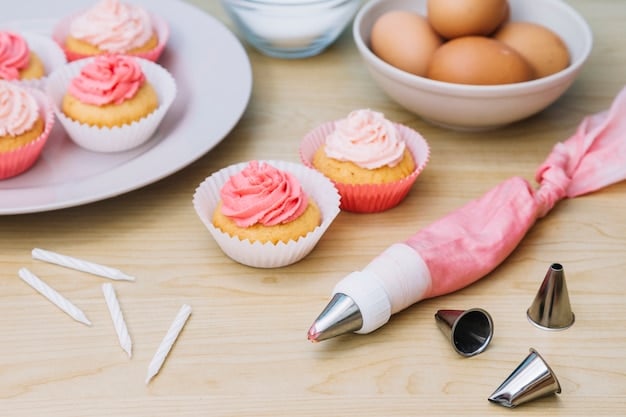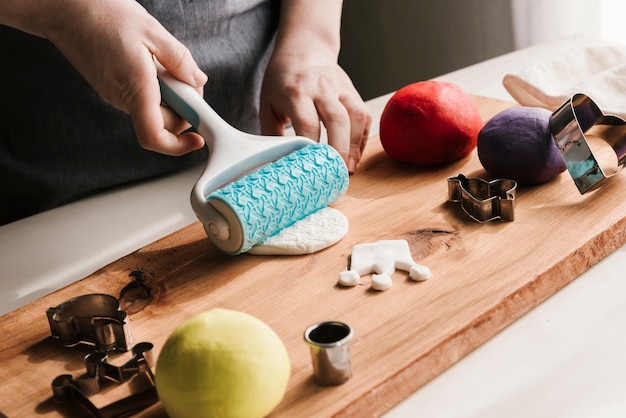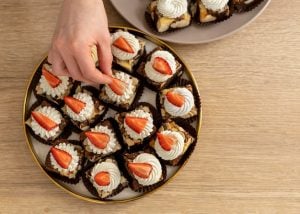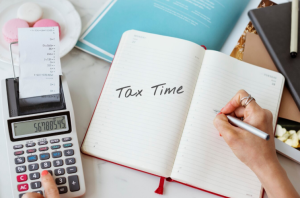Professional bakers agree on eight essential tools for cake decorating: offset spatulas, piping bags with tips, turntables, bench scrapers, levelers, smoothers, stencils, and cake boards. These tools are super important for turning cake batter into beautifully decorated cakes that are perfectly smooth and full of creative details.
Whether you’re adding texture with edible decorations or perfecting the shape of your cake with a cake leveler, having the right tools makes all the difference. These items ensure that your cakes not only look stunning but also have the finesse of a professional, whether you’re decorating with sugar, working with fondant, or using hot water to smooth out the icing.
Investing in these handy tools turns cake decorating into so much fun, helping you to elevate your creations whether you’re a beginner or a seasoned baker. A cake stand is also essential to display your cakes and make the decorating process smoother. These tools don’t just help create a fun project but will also make your cakes the star of the show at grocery stores or any event.
Let’s dive into each tool, understand its role in your decorating process, and discover which brands provide the best value for your money.

Save 80% of delivery management time
We handle everything:
- Dedicated operations manager
- Real-time tracking dashboard
- Automated customer notifications
- Urgent issue resolution
Quick Answer: What Essential Cake Decorating Tools Do Bakers Use?
Essential tools include piping bags, nozzles, spatulas, scrapers, and turntables.
Basic tools help create smooth cakes and intricate designs effortlessly.
Misconceptions About Cake Decorating Tools
Many people believe that cake decorating requires complicated tools. This isn’t true. Basic items like piping bags and spatulas can do the trick. Even professional results are possible without extravagant gadgets. The focus should be on mastering these essential tools. Simple techniques can often lead to the most stunning designs, as seen in many cake competitions.
Some think all spatulas are the same. Actually, there are variations for different tasks. An offset spatula, for example, is ideal for spreading icing evenly. It’s great for reaching the bottom of tall cakes without mess. Each tool serves a specific purpose. Understanding these functions can significantly enhance your decorating skills.
Finally, there’s a belief that turntables are only for professionals. Not true. A turntable makes the decorating process smoother for everyone. It allows you to apply icing evenly, providing a polished look. In fact, it’s a valuable tool for bakers at any level. Instead of being an advanced tool, it’s a basic necessity for quality cake finishes.
Common Tools and Their Importance
Piping bags are a decorator’s best friend. They allow for precise icing placement. With various nozzle tips, you can create countless designs. Rosettes, stars, and borders are just a start. Consistency in pressure application is key for neat designs. This practice is essential whether you are a beginner or a seasoned baker. Remember, neatness comes with practice.
Scrapers and spatulas are used for smoothing and spreading. A straight spatula can tackle large surfaces effortlessly. It helps in achieving those perfect flat finishes on cakes. Scrapers add creativity; they can introduce patterns or textures. Using just a scraper, a plain cake can transform into an elegant, textured delight.
Another vital tool is the turntable. It offers ease and precision in decorating. By rotating the cake, a decorator can work methodically. This tool reduces the chances of uneven icing. As one expert noted, it makes the decorating process much easier. Turntables allow for a flawless finish, setting the foundation for more detailed work later.
Achieving Professional Results at Home
With the right tools, anyone can create a professional-looking cake. Start with good quality items. A well-made piping bag and sturdy nozzles make a significant difference. Invest in durable spatulas and scrapers. Quality ensures better results and a pleasant decorating experience.
Practice is crucial. Consistent efforts with basic tools vastly improve skills. It’s common for bakers to start small, decorating cupcakes or single-tier cakes. As confidence builds, more complex designs can be tackled. Start with simple patterns and gradually work up to intricate designs.
Professional results are largely about technique. Practicing with essential tools prepares you for advanced projects. Emphasize learning how each tool enhances your creativity. As you build your skills, consider personalizing your designs. Remember, personalization adds uniqueness to any cake. According to Kelly Gray, it’s about pulling unique details into designs in a sophisticated manner. If you’re considering turning your baking passion into a business, starting a cake business can be a rewarding venture. With the rise of personalized baked goods, now is the perfect time to explore the steps needed to transition from home baker to professional. To find out more about launching a cake business for sweet success in 2025, check out this guide.
Starting your own cake business not only allows you to share your creations with others but also enables you to have a fantastic source of income. Understanding the market and the needs of your customers is crucial. Consider focusing on niche offerings, like vegan or gluten-free cakes, to stand out in a competitive market. For those interested in diving deeper into this topic, find out more about starting a successful cake business in 2025.
Additionally, understanding how to set prices for your cake offerings is crucial. Many bakers struggle with determining the right price point that balances affordability for customers while ensuring profitability for themselves. Being informed about market trends can help you establish a pricing strategy that works for both you and your clientele. To learn more about effective cake pricing strategies, check out this insightful article on Setting Cake Pricing That Works for You and Your Customers.
Why Are These Tools Essential for Cake Decorating?
They offer precision, helping bakers craft exact designs with ease.
Even beginners can produce professional cakes.
Consistent textures and symmetry boost a cake’s look.
Precision and Ease of Use
Precision is key in cake decorating. Tools like piping nozzles and spatulas are vital in achieving that. They let bakers execute designs accurately, enhancing intricate details. Turntables, for example, are necessary because they help apply icing evenly, which is crucial for both basic and complex designs. These tools are not just about ease; they invite expertise. “Cake decorating tools are essential for achieving precision, detail, and consistency,” notes a source emphasizing the necessity of specialized equipment.
Beyond piping bags and turntables, offset spatulas allow for smooth frosting and sharp edges. They are ideal for achieving that neat finish that professional bakers strive for. Many bakers report initial struggles without the proper tools. However, investing in them leads to a more controlled decorating process. This control saves time, reduces frustration, and boosts creativity.
Achieving Professional Results Regardless of Experience
A common misconception is that professional cake decorating requires years of experience. The truth is, that the right tools can significantly bridge this experience gap. Beginners can yield results that rival seasoned bakers by simply choosing suitable equipment. Essential items like piping tips, couplers, and cake combs are pivotal. They empower users to explore varied designs. Learning to use these tools effectively enhances decorating skills.
It’s not about having a vast array of tools, but more about knowing how and when to use them. Tools like cake combs help create textured surfaces, while a simple turntable can elevate a design from homemade to bakery-standard. A baker shared their experience of starting simple and progressing as they honed their skills with the right equipment. The leap in the quality of their work was immense.
Consistency and Symmetry Enhance Visual Appeal
Consistency in texture and symmetry is what truly defines the visual appeal of a cake. Tools like bench scrapers and palette knives are key in achieving this. They ensure that the icing is smooth, and the cake’s shape is even. Without these, even the best recipes can fall flat in presentation. The visual quality of a cake matters as much as its taste, reflecting the baker’s skill and attention to detail.
Turntables and scrapers are especially useful for maintaining symmetry. They allow for a stable and rotational view of the cake, making it easier to spot any discrepancies on the surface or sides. Achieving this symmetry not only leads to a more professional look but also enhances the overall aesthetic impact of the design. In cake decorating, this level of detail distinguishes a good cake from a great one.
By understanding the importance of these tools, bakers can navigate the complexities of cake decorating with greater confidence and creativity.

How to Select Essential Cake Decorating Tools Such as Cake Levelers and Piping Bags
Match tools to your cake decorating needs.
Choose starter kits if you’re just beginning.
Focus on quality for long-lasting tools.
Identify Specific Needs: Icing, Trimming, or Sculpting
First, think about what you need for your cake-decorating tasks. Do you need tools for icing, trimming, or sculpting? Different tasks require different tools. Identifying your needs will help you pick the right ones. For icing, you’ll need piping tips and bags. Piping tips are essential for creating patterns and designs. For trimming, a good serrated knife or cake leveler is useful. If sculpting fondant, special tools like fondant smoothers and sculpting sticks are essential. Clear identification of tasks can ensure you only get what’s necessary, avoiding clutter and wasted expenses.
Consider Starter Kits if You Are a Beginner
If you’re new to cake decorating, starter kits are a practical choice. These kits usually have a range of essential tools. They include items like piping bags, tips, couplers, and spatulas. One popular kit is the Wilton How to Decorate Cakes and Desserts Kit, complete with tools and an instruction booklet. Another option is the Kootek All-In-One Cake Decorating Kit, known for its affordability. Using a kit as a beginner simplifies the learning process. It provides a structured starting set without overwhelming you with too many choices.
Essential Elements of a Starter Kit
When looking into starter kits, check what’s included. Essential components should have:
Variety of piping tips for different designs.
Offset spatula for smoothing and leveling icing.
Cake combs for textured finishes.
Couplers to switch tips easily.
Invest in Quality Over Quantity
Finally, prioritize quality over quantity. High-quality tools last longer and work better. Durable tools like metal offset spatulas and stainless steel piping tips provide longevity and reliability. Rather than buying many cheaper tools, focus on a few robust ones. As highlighted by experts, investing in quality makes decorating more effective and enjoyable. Cheaper tools might save money upfront, but they often wear out. This can affect both performance and final results. High-quality tools might be pricier, but they’re a good long-term investment.
Remember, building a collection of reliable decorating tools enhances your decorating skills and ensures beautiful cakes. The right tools simplify even the most challenging designs and set you up for success.
How to Prevent Issues When Decorating Cakes?
Start simple, master the basics first.
Organize and clean your tools.
Learn new techniques with online tutorials.
Practice Basic Techniques Before Moving to Complex Designs
Understand the Basics: Begin with the basic techniques like frosting and simple piping. Getting a handle on basic techniques builds confidence.
Work with Dummy Cakes: Use dummy cakes to practice. These are foam-based cakes used for training. Practicing on them avoids waste and provides room for mistakes.
Master the Crumb Coat: Apply a crumb coat to your cakes. A crumb coat is a thin layer of frosting applied to seal crumbs before the final layer. This creates a smooth surface for your final design and prevents crumbs from showing.
Develop Piping Skills: Practice piping on parchment paper. Use different nozzles to understand their effects. Consistent pressure and steady hands are crucial during this practice phase.
Gradual Transition to Complex Designs: Once comfortable with the basics, slowly try more complex designs. Avoid jumping into intricate patterns too quickly.
Tools Needed for Practice
Piping bags and various nozzles
Parchment paper
Dummy cakes or practice boards
Offset spatula
Keep Tools Well-Organized and Cleaned to Maintain Their Effectiveness
Sort Tools Efficiently: Arrange tools by function and size. Use bins or drawer organizers to separate them. Make sure each tool has a set place for easy access.
Regular Cleaning Routine: Clean tools after each use to prevent residue build-up. Residual icing can affect the performance of tools like piping nozzles.
Proper Storage Techniques: Store your piping bags flat and folded. This avoids creases and maintains flexibility. Keep spatulas and scrapers in a dedicated space, avoiding overlap.
Maintenance Checks: Inspect tools regularly for wear and tear. Replace any damaged tools to maintain efficiency in decorating.
Invest in a Tool Organizer: Consider buying a tool organizer, especially if you have numerous tools. This helps in keeping everything in place and prevents clutter.
Tips for Ensuring Clean Tools
Use gentle dish soap and warm water for cleaning.
Dry tools completely before storing them.
Store metallic tools separately to prevent rust.
Stay Updated with Online Tutorials for the Latest Techniques and Tips
Regularly Watch Tutorials: Online tutorials offer insights into new techniques and trends. Subscribe to channels or websites focused on cake decorating. This keeps you informed with the latest trends and offers new design ideas.
Join Forums and Groups: Participate in online communities. These platforms provide tips, trends, and solutions to common issues in cake decorating.
Experiment with New Techniques: As you learn new methods, practice them alongside your existing skills. This keeps your skills fresh and adaptable to changing styles.
Keep a Learning Journal: Document techniques you learn. This helps retain information and provides a reference for future projects.
Seek Interactive Sessions: Attend webinars or live demonstrations when possible. Engaging with the host allows you to ask questions and gain a deeper understanding.
Resources for Learning
YouTube cake-decorating channels
Baking blogs and online courses
Forums dedicated to cake decorators
By following these steps, you can significantly minimize potential problems during cake decoration. Not only does this guide enhance your skills, but it also reduces stress, making cake decorating an enjoyable process.
Learning to Emphasize Precision in Other Baking Tasks
Precision in measuring ingredients ensures consistency.
Consistent textures improve baked goods quality.
Detailed presentation enhances the visual appeal.
Develop a Keen Eye for Detail When Measuring Ingredients
Precision in measuring ingredients is critical for baking success. Baking is an exact science, unlike cooking which can be more flexible with portions. Variations in ingredient amounts can lead to entirely different textures and flavors. Scientific books like “On Baking: A Textbook of Baking and Pastry Fundamentals” delve into why ingredient measurement is critical.
This book explains how measuring by weight, rather than volume, reduces errors. Glass and plastic measuring cups may produce different results due to density and human error. By using a digital kitchen scale, bakers can achieve consistent outcomes time after time. An experiment mentioned in a Perfectly Pastry article demonstrated how using different measuring cups for 1 cup of flour can result in varied weights, reaffirming the importance of using weight for precision.
However, a downside is that digital scales need batteries and may require recalibration over time. Some may argue that measuring by volume saves time, but in the professional world, consistency outweighs convenience. For those keen on deepening their understanding, textbooks like “Professional Baking” by Wayne Gisslen offer more on the subject.
Practice Creating Consistent Textures in Doughs and Batters
Achieving consistent textures in doughs and batters demands both skill and attention to detail. Factors such as the flour-to-water ratio are essential in crafting quality doughs. For a pliable dough, a 2:1 flour-to-water ratio is often recommended.
For example, 500g of flour should be paired with 250 mL of water, as detailed in an article on dough preparation. Letting the dough rest allows the gluten to relax, yielding a smoother texture. Books like “The Bread Baker’s Apprentice” by Peter Reinhart provide deep insights into the science of dough-making, teaching bakers to recognize subtle texture changes.
The challenge lies in handling these processes with care to avoid tough or flat outcomes. On the other hand, some traditional methods might argue for intuitive adjustments, where an experienced baker gauges the texture by feel. For those looking to explore these traditional approaches further, reading “Classic German Baking” by Luisa Weiss could offer historical context and techniques.
Adapt Precision to Plating and Presentation for Enhanced Food Appeal
Plating and presentation require as much precision as the baking process itself. An appealing dish begins long before it ever reaches the table. Plating isn’t just about placing food on a plate; it’s about telling a story visually.
Using tweezers for positioning garnishes or a small brush for sauce application can elevate the dish. Resources like “The Art of the Dessert” by Ann Amernick can offer creative perspectives on presentation. The downside is the time investment required for each dish, which might be burdensome for busy kitchens.
Yet, the visual appeal can significantly enhance the eating experience, potentially justifying the additional effort. Critics might argue that in high-volume settings, extensive plating isn’t feasible. However, even small touches can make a difference. “The Flavour Bible” by Karen Page also offers insight into pairing flavors and aesthetics, broadening the baker’s skill set beyond the kitchen. Engaging with online culinary courses can also offer hands-on exposure to advanced techniques.
Supplementary Information: Understanding Cake Decorating Tools
Learn the types and uses of different decorating nozzles.
Discover the best materials and features in cake scrapers.
Get tips for a professional finish and explore innovative gadgets.
1. Types of Cake Decorating Nozzles
Cake nozzles, also known as piping tips, are crucial in any baker’s toolkit. They shape the icing and deliver precise patterns that enhance cake aesthetics. Understanding the difference between the types is key for proper execution. Round nozzles, with their straightforward designs, are often for detailed work like writing and dot patterns.
They help achieve the sharp edges necessary for a clear, legible script. Star nozzles, recognizable by their multi-pronged designs, are popular for creating visually appealing effects like rosettes or shell borders. Bakers can add elegance with minimum effort by simply varying the pressure and angle. Advanced decorators often layer star patterns for dynamic textures. Learning to use these nozzles effectively can transform a simple cake into a piece of art.
Exploring authoritative resources can deepen one’s understanding of these techniques. The guide by Naomi Cakes offers comprehensive insights on piping techniques, ensuring broad skill development. Chefs and amateurs alike should consult blogs or courses focused on piping mastery to gain a competitive edge. They can also follow detailed demonstrations, like the YouTube tutorial by Elsweets, to observe experts in action. While it requires practice, the payoff can enhance both confidence and creativity.
2. Choosing the Best Cake Scraper
Cake scrapers, or icing smoothers, profoundly influence the overall texture and appearance of cake surfaces. When selecting a scraper, material choice matters. Stainless steel and silicone are favored for their durability and ease of cleaning.
Stainless steel provides the rigidity needed for precise edges, making it perfect for achieving the much-desired “sharp edge” look. Silicone, being more flexible, is gentle on softer creams and is often better suited for curved surfaces. Some scrapers offer combinations of both materials, balancing flexibility with firmness.
Features such as comfortable grips and varied edge designs add an extra layer of convenience. Bakers should pay attention to the texture, grip, and angle of the scraper handle, which affects control.
A multi-edged scraper can offer versatility in creating different visual effects. It’s about striking a balance between comfort and functionality. Professional bakers often recommend having several types for varied tasks, allowing their creativity to flow unhindered.
For more comprehensive reviews on different cake scrapers, The Spruce Eats offers thorough testing and evaluations. They highlight the importance of grip and edge types in achieving consistent results.
3. Professional Cake Decoration Tips
Creating intricate designs requires steadiness and control. Master decorators advise working slowly to ensure precision. A steady hand minimizes errors and allows for greater detail in intricate patterns. Turntables are pivotal in this process. They allow for smooth and continuous movement, ensuring consistent icing thickness and symmetry. Using a turntable reduces the strain on hands and arms, improving overall control.
The expertise of renowned bakers emphasizes patience and practice in developing these skills. The Chelsweets blog offers practical tips on achieving seamless designs and speaks to the importance of an efficient workflow. Adopting these practices can lead to significant improvements in decorating finesse.
Bakers are also encouraged to explore professional workshops or training videos to refine their techniques further. Engaging with a community, whether online or in-person, provides valuable feedback and support, enhancing overall skill growth.
4. Innovative Cake Decorating Gadgets to Consider
Modern cake decorating benefits from a range of high-tech gadgets. Airbrush kits are increasingly popular as they provide smooth, consistent coloring that traditional methods can’t match. These kits cover large areas evenly and allow for layers of nuanced shading. They are particularly useful for blend transitions and creating realistic shadows. Successful use of airbrush kits requires a learning curve, but the results can elevate the cake’s appeal significantly.
Impression mats offer another innovative option. These silicone mats allow decorators to imprint textures onto fondant or buttercream. They add dimension to designs that would be hard to achieve manually. With a variety of patterns available, from floral to geometric, bakers can easily adapt their cakes to suit any occasion.
Investing in these tools expands the potential for customization and precision in cake design. Resources like Medinabaking highlight trends such as these, emphasizing the edge they offer to serious decorators. Exploring these new technologies invites even novice bakers into professional territory.
To delve deeper, reading advanced cake decorating books can be beneficial. Titles by authors such as Christina Tosi offer insights into combining innovative tools with traditional techniques for outstanding results.
5. Top-Rated Baking Supplies Every Baker Needs
Some supplies remain a staple in every baker’s kitchen. Reliable oven thermometers are crucial in assessing correct baking temperatures, as even slight variations can affect the texture and rise of a cake. Non-stick baking mats ensure uniform heat distribution and ease of cleanup, making them practical as well as efficient. Their use can eliminate common baking missteps like uneven baking or difficult cake release.
Quality baking supplies simplify the process, allowing for consistent and repeatable outcomes. Investing in these items provides reassurance during critical baking stages. The Spruce Eats outlines crucial tools that contribute to a seamless baking experience. These essentials form the backbone of an effective baking toolkit.
Finally, staying attuned to industry developments, such as new materials or novel equipment, ensures one’s skills and resources stay updated and efficient. References like Chelsweets maintain informative lists of must-haves that adapt to evolving techniques.
Conclusion
Professional cake decorating depends on having the right tools and knowing how to use them. The tools we discussed will help you create beautifully decorated cakes with smooth finishes and precise details. A well-organized toolkit with quality items like piping bags, nozzles, and a reliable cake turntable forms the foundation of successful cake decorating.
Start small with basic tools and build your collection as your skills grow. Focus on mastering fundamental techniques before moving to complex designs, such as adding decorative borders, using metal tips, and achieving a clean cut with your knife. Clean and maintain your tools properly to ensure they last longer and perform consistently. Remember that even experienced bakers started with simple designs and gradually improved their skills through practice. With some fondant, buttercream, or chocolate, you can start exploring the endless possibilities for wedding cakes and other special creations.
Whether you’re a home baker or aspiring professional, investing in quality cake decorating tools will improve your work significantly. Having the essentials like food coloring, sprinkles, and parchment paper is a game changer when it comes to getting creative with different colors and textures. Keep learning through online tutorials and practice regularly. The cake decorating community is supportive and always sharing new techniques, so don’t hesitate to ask for tips from your local craft store near you.
Today’s basic tools like cake pans and cake layers can help you create tomorrow’s masterpieces. Your dedication to precision, combined with the right equipment, will help you develop impressive cake decorating skills. Start with these decorating essentials, practice consistently, and watch your creations become more professional with each cake you frost and fill.



























